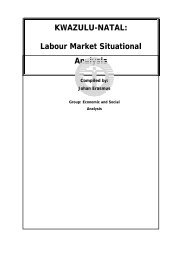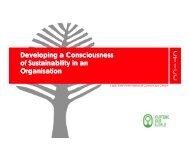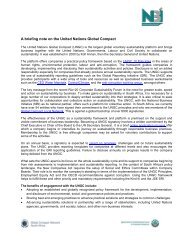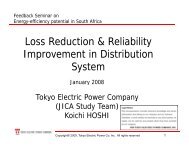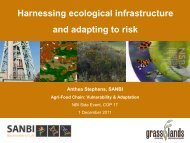Sustainable Forest Finance Toolkit - PwC
Sustainable Forest Finance Toolkit - PwC
Sustainable Forest Finance Toolkit - PwC
- No tags were found...
You also want an ePaper? Increase the reach of your titles
YUMPU automatically turns print PDFs into web optimized ePapers that Google loves.
Appendix 1: Special places 3 of 3Developed by Definition Characteristics Management preferences NotesNaturaNetworkingProgrammeNatura 2000 Sites(Natura NetworkingProgramme, 2007;EuropeanCommission, 2003)A network of Special Protection Areas (SPAs) and Special Areas of Conservation (SACs) inthe European Union. SPAs are for the protection and management of areas important forrare and vulnerable birds as specified by the EU Parliament Birds Directive, while SACs areareas established for the protection and management of rare and vulnerable animal andplant species, and habitats, as specified by the EU Parliament Habitats Directive. Amongother things, the Birds Directive seeks to conserve, maintain or restore the biotopes andhabitats of all bird species naturally living in the wild in the European Union (European Union,2006). The Habitats Directive includes:• Natural habitats in danger of disappearance in their natural range• Those having small natural range following their regression or by reason of theirintrinsically restricted area• Those presenting outstanding examples of typical characteristics of more of the followingbiogeographical regions: Alpine, Atlantic, Continental, Macronesian and Mediterranean(European Union, 2007)Appropriate economicactivity to maintain orimprove the conservationstatus of Natura 2000 Sitesis allowed. Member statesidentify and propose a list ofsites for their territory andare in charge of managingthese sites. Managementcan include strictly protectionand sustainablemanagement.Natura 2000 Sites are identified andproposed by countries. For each site,national governments submit standardinformation describing the site and itsecology; this information is to be validated bythe European Topic Centre for NatureConservation. A complete GIS database ofNature 2000 Sites will be built aftercompilation and validation. Detailedinformation and maps can be obtaineddirectly from the national governments. Linksto governmental institutions with informationcan be found atwww.ec.europa.eu/environment/natureSFI<strong>Forest</strong>s withexceptionalconservation value(FECV) (SFB, 2004)Globally threatened or rare forests, with high levels of endemism, or that have little humanintervention; forests containing high biodiversity value, unique or rare forest communities,viable populations of rare individual plant and animal species.Managed in a way thatprotects their uniquequalities and promotesconservation of biodiversity.FECVs are identified with assistance frominformation provided by NatureServe in theUS and Canada. Outside North America,these areas can be identified in base ofbiodiversity hotspots and other importantareas in the tropics.WildlifeConservationSocietyLast of the wild(Sanderson et al.,2002)The largest, least influenced areas around the world where the full range of nature may stillexist with a minimum of conflict with existing human structures. The last of the wild wereidentified based on an assessment of the human footprint, which compiles the followingtypes of data as proxies for human influence: population density, land transformation,accessibility, and electrical power infrastructure.These areas are a guide toopportunities for effectiveconservation.569 places have been identified. Maps areavailable atwww.ciesin.columbia.edu/wild_areas/World BankCritical forests (WorldBank, 2002B)Critical forest areas are the subset of natural forest lands that cover:• Existing protected areas and areas officially proposed by governments as protectedareas, areas initially recognised as protected by traditional local communities, and sitesthat maintain conditions vital for the viability of these protected areas.• Sites identified as recognised by traditional local communities; areas with known highsuitability for biodiversity conservation; and sites that are critical for rare, vulnerable,migratory, or endangered species.Definition is for internalpurposes. The Bank wouldnot finance projects thatwould involve significantconversion or degradation ofcritical forest areas.Critical forests are identified by the bank oran authoritative source determined by theregional environment sector unit.WRIFrontier forests(Bryant et al., 1997)Relatively undisturbed large tracts of forests are capable of sustaining viable populations ofall native species.No managementpreferences outlined.Maps available at www.globalforestwach.orgWWFGlobal 200 (WWF,2007)Outstanding and representative eco-regions of each major habitat type in the world based ontheir biodiversity patterns and degree of threat. Global 200 harbour globally importantbiodiversity and ecological processes and represent the world’s most outstanding exampleswithin each major habitat type.Primary objective is topromote their conservation.Maps available at www.worldwildlife.org.WWF also uses the HCVF concept to definespecial places at a more local scale.Page 83pwc



